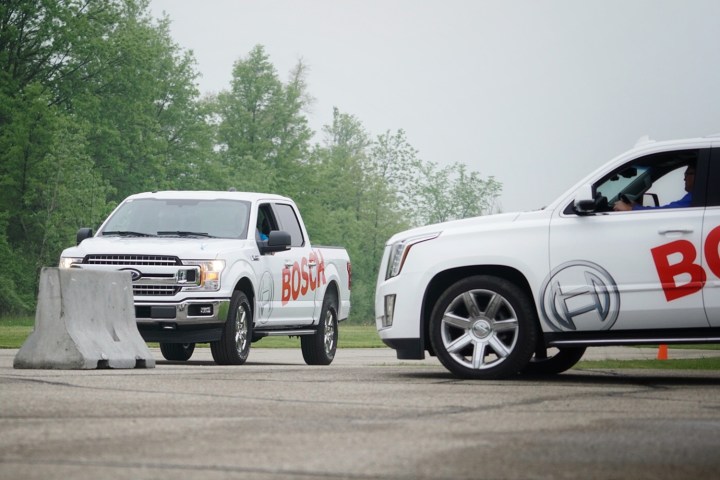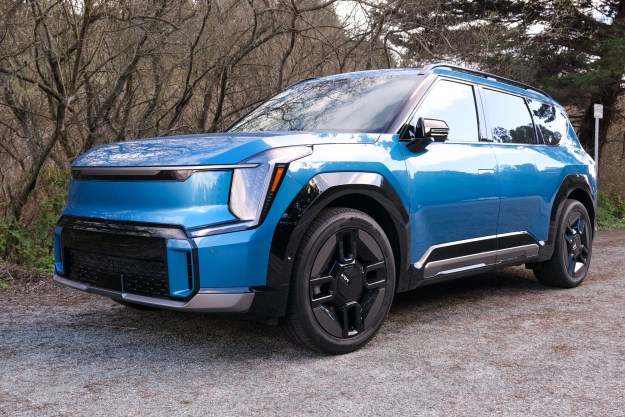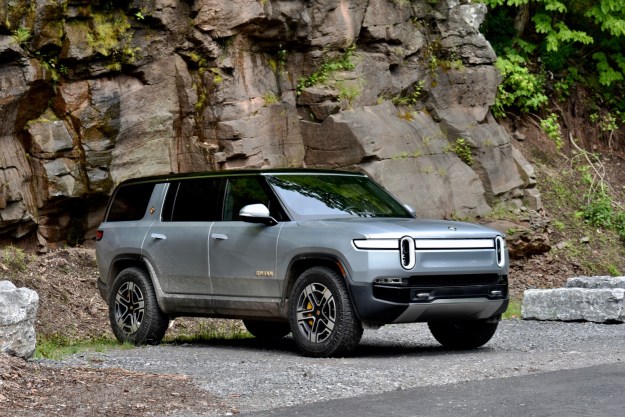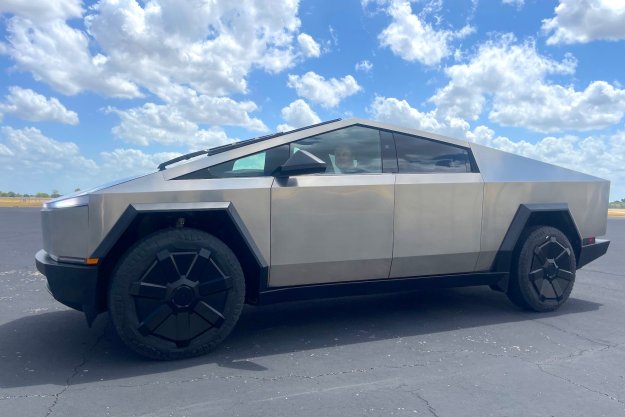
Many years ago, I was crossing the street on the way to school. The crossing guard held out the stop sign for me and my friends, and we started across the street. A car in the nearest lane obediently stopped, and we walked to the second lane without thinking about it. But a driver coming up fast in that lane didn’t see us until we emerged from behind the stopped car. He slammed on the brakes and skidded to a stop just a few feet from our surprised faces. As scared as we were, that driver was flat terrified. We all walked on, but I’ve never forgotten that moment.
Fast forward to the present, and I’ve just seen technology that made me recall that day.
At the Bosch proving grounds near Detroit, Michigan, Bosch engineers showed Digital Trends how roads in the future will communicate with vehicles and let them know when people are crossing. That’s just one application of a coming technology called vehicle-to-anything communications, or V2X.
What is V2X?
V2X is based on Dedicated Short Range Communications (DSRC), which is a short- to medium-range wireless standard that permits very high data-transmission rates. It’s very close to Wi-Fi, and the maximum range is about 1,000 feet.
DSRC operates on dedicated frequencies on the 5.9 GHz band, and both cars and infrastructure can send and receive the signal.
Both cars and infrastructure can send and receive the signal. So for example, simple cameras could register the presence of people in a crosswalk, and the intersection hardware can broadcast that information using DSRC to notify approaching cars of that fact. The cars would then flash a message to their drivers, and pre-charge their own automatic emergency braking systems, just in case.
But here’s another thing: Communication can be two-way, with the cars transmitting information about their status, as well as receiving information from the roadway infrastructure. So cars can talk to other cars (Vehicle to Vehicle or V2V) as well as the infrastructure (V2I).
“What each vehicle is doing is transmitting what’s called a basic safety message,” says Bosch product and engineering manager Phil Ventimiglia. “Within that basic safety message, which is transmitted 10 times a second, there’s a whole host of information about the vehicle itself. It contains the vehicle heading, vehicle speed, and GPS location. It also contains information about the vehicle’s size, the acceleration of the vehicle, the brake status of the vehicle, among other things. The vehicle that’s about to be warned is listening to that, constantly.”

While at Bosch’s proving ground, we saw a demonstration of two vehicles approaching an intersection at right angles. V2V communication with that basic safety message allowed them to avoid a collision in much the same way that current automatic emergency braking works.
“Other automated systems work well, obviously,” Ventimiglia observes, “so the radars and the camera systems can help with those type of scenarios. Where V2X excels is when there’s no line of sight for the camera or the radar. The V2X can still listen and hear that other vehicle coming.”
Can V2X handle the real world?
Watching two vehicles demonstrate the tech in a controlled environment is one thing, but we wondered what happens when you’re in the middle of a traffic jam.
“Let’s say in very high-density situations it could be a lot of vehicles, theoretically hundreds,” Ventimiglia explains. “But we also have technology built in, what we call congestion control, so as we detect that a lot of vehicles are also transmitting, we decrease the power output of the system. We effectively reduce the range of the vehicles themselves, so you can’t listen and hear as many other vehicles in the environment, so your scope is reduced. Because obviously the vehicles that are very close to you are the ones that you’re more interested in.”
Another example of V2V application is reducing the “accordion effect.”
Cadillac released a statement stating that the brand will release V2X in at least one crossover SUV by 2023.
“There’s one application that we call electronic emergency brake light,” Ventimiglia says. “If you imagine your vehicle, and there’s a vehicle ahead of you, and one more vehicle ahead of that, if the driver all the way in the front hits the brakes hard, it creates a chain reaction. But now when this vehicle brakes, and he’s transmitting on DSRC, your car knows instantly, and you don’t have that kind of chain reaction of brakes piling up.”
The U.S. Department of Transportation has a list of potential DSRC applications for V2V and V2I applications, including do-not-pass warnings, intersection collision avoidance and movement assistance, approaching emergency vehicle warning, emergency vehicle signal priority, rollover warning, commercial vehicle clearance and safety inspections, parking and toll payments, and traffic or travel condition data to improve traveler information and maintenance services.
Crowdsourcing a parking spot
Another use for V2X is to help you find parking in crowded areas. It works a lot like the other functions, but it uses ultrasonic sensors. Here’s how it works: Participating vehicles have programming to note the location of available parking spaces when suitable spaces are perceived by their cameras. That information is reported using the vehicle’s cellular connection and other participating cars can display the locations of nearby available parking spaces on their navigation systems in real time. Bosch has this system working today, and demonstrated it for us in downtown Detroit.

“I think Bosch is well positioned there, and could actually combine a lot of those technologies together, and use V2X data as really an additional sensor in the vehicle to make life a little more convenient for the drivers, as well as more safe,” Ventimiglia says.
But is it secure?
Data security is one of the first concerns that comes to mind with any new tech, and DSRC is no exception. Can V2X communications be put to criminal uses? Certainly someone will try, and they might succeed, but engineers like Ventimiglia are doing their best to anticipate problems.
Within that basic safety message there’s a whole host of information about the vehicle itself.
“We provide a security prudential management system in the box, and we can also provide the back-end solutions,” he says. “So that when a vehicle or an infrastructure is transmitting the messages, they’re signed and secure. The vehicles make sure they only listen to the signed messages, and then you would know that you can trust the system, that somebody isn’t trying to spook a vehicle or an infrastructure.”
There’s also V2G
If you thought all the applications of V2X have been listed, think again. There’s also the potential for this technology to eliminate trips to the DMV or the smog station. While your vehicle is talking to the infrastructure, it can also relay messages about your car’s emissions control systems, and automatically renew your registration, or pay road tolls and parking charges. Collectively, these functions are known as V2G – Vehicle to Government communications.
When will you have this on your car?
The point of Bosch’s demonstrations was to give us an advance look at the technology coming down the line in the next few years. “We’ve received some inquiries from automakers and we’ve responded to those, and we’re waiting for the industry to basically source and move forward,” Ventimiglia says.
Not coincidentally, within days of experiencing this technology in Bosch’s backyard, Cadillac released a statement stating that the brand will release V2X in at least one crossover SUV by 2023 and eventually expand the technology across Cadillac’s portfolio. Cadillac first introduced V2V communications using DSRC on the CTS sedan in 2017.

Mark Reuss, GM executive vice president of Global Product Development, Purchasing and Supply Chain, announced these plans at the Intelligent Transportation Society’s annual conference in Detroit.
“The expansion of Super Cruise and V2X communications technology demonstrates Cadillac’s commitment to innovation, and to making customers’ lives better,” Reuss said.
Toyota has also announced plans to move forward with V2X on both the Toyota and Lexus brands, as has Volkswagen/Audi, and Ford. Other automakers such as Volvo are working on related technologies.


